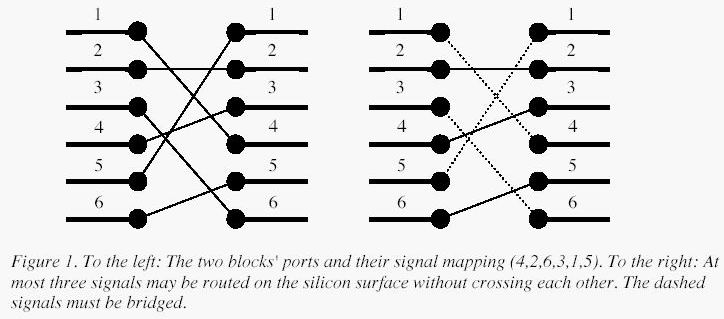Bridging signals
| Time Limit: 1000MS | Memory Limit: 10000K | |
| Total Submissions: 11025 | Accepted: 6043 |
Description
'Oh no, they've done it again', cries the chief designer at the Waferland chip factory. Once more the routing designers have screwed up completely, making the signals on the chip connecting the ports of two functional blocks cross each other all over the place. At this late stage of the process, it is too expensive to redo the routing. Instead, the engineers have to bridge the signals, using the third dimension, so that no two signals cross. However, bridging is a complicated operation, and thus it is desirable to bridge as few signals as possible. The call for a computer program that finds the maximum number of signals which may be connected on the silicon surface without crossing each other, is imminent. Bearing in mind that there may be thousands of signal ports at the boundary of a functional block, the problem asks quite a lot of the programmer. Are you up to the task?

A typical situation is schematically depicted in figure 1. The ports of the two functional blocks are numbered from 1 to p, from top to bottom. The signal mapping is described by a permutation of the numbers 1 to p in the form of a list of p unique numbers in the range 1 to p, in which the i:th number specifies which port on the right side should be connected to the i:th port on the left side.Two signals cross if and only if the straight lines connecting the two ports of each pair do.

A typical situation is schematically depicted in figure 1. The ports of the two functional blocks are numbered from 1 to p, from top to bottom. The signal mapping is described by a permutation of the numbers 1 to p in the form of a list of p unique numbers in the range 1 to p, in which the i:th number specifies which port on the right side should be connected to the i:th port on the left side.Two signals cross if and only if the straight lines connecting the two ports of each pair do.
Input
On the first line of the input, there is a single positive integer n, telling the number of test scenarios to follow. Each test scenario begins with a line containing a single positive integer p < 40000, the number of ports on the two functional blocks. Then follow p lines, describing the signal mapping:On the i:th line is the port number of the block on the right side which should be connected to the i:th port of the block on the left side.
Output
For each test scenario, output one line containing the maximum number of signals which may be routed on the silicon surface without crossing each other.
Sample Input
4 6 4 2 6 3 1 5 10 2 3 4 5 6 7 8 9 10 1 8 8 7 6 5 4 3 2 1 9 5 8 9 2 3 1 7 4 6
Sample Output
3 9 1 4
给你n个数,让你求出最长上升子序列,O(n*n)的算法肯定TLE,所以要用n*logn的算法(算法分析详看上一篇),POJ 3903与之相比,只是数组开大点就行了。。
#include <iostream> #include <cstring> #include <cstdio> using namespace std; const int N = 40010; int erfen(int key,int right,int b[]) { int left=0; int mid=(left + right) / 2; while(left <= right) { if(b[mid] < key) left=mid+1; else if(b[mid] > key) right=mid-1; else return mid; mid=(left + right) / 2; } return left; } int main() { int T; cin>>T; while(T--) { int n; int a[N] , b[N]; cin>>n; for(int i=0;i<n;i++) scanf("%d",&a[i]); b[0]=-1; b[1]=a[0]; int ans=1; for(int i=1;i<n;i++) { int j=erfen(a[i],ans,b); b[j]=a[i]; if(j>ans) ans=j; } printf("%d\n",ans); } return 0; }























 152
152











 被折叠的 条评论
为什么被折叠?
被折叠的 条评论
为什么被折叠?








